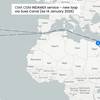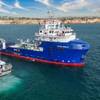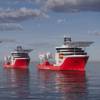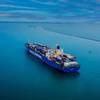Ballast water management is to become a major consideration in the design of new vessels following the approval by IMO of a series of measures aimed at reducing the harmful effects of marine organisms transported in ballast water and the risks involved in some ballast water management techniques.
The 47th session of the International Maritime Organization’s Marine Environment Protection Committee (MEPC), which met from 4 to 8 March at IMO Headquarters in London, approved a Circular containing a raft of design suggestions for ballast water and sediment management options in new ships.
As a fundamental principle, the Circular states that ballast water management and the processes chosen to achieve it should be considered as a basic component of a ship’s design and that ballast tank design should facilitate all aspects of ballast water management.
Installation of recording equipment should be considered for all ballast water operations and treatment actions and it should be possible for these records to be readily available to appropriate authorities that may request copies.
The Circular goes on to state that ballast water system designs should take special account of the increased need for content sampling, with an aim to enhancing the quality and ease of sampling of ballast water and sediments, without the need to enter potentially dangerous spaces or to partially fill ballast tanks.
Where ballast water exchange at sea is the chosen method, the overall design, strength and stability of the ship should be sufficient to permit its execution on all ballast voyages and in all except severe weather conditions. For the guidance of the master, the maximum sea state and swell conditions identified by the builder, if any, in which ballast water exchange can safely be carried out should be recorded in a Ballast Water Management Plan, which should be created for every ship. This plan should give guidance on safe and effective operation of the various ballast water management and treatment options that are considered appropriate for the ship.
The design of the ship should include consideration of the consequences of ballast water exchange at sea including: stability, hull girder strength, shear forces, resonance, sloshing, stemming, propeller immersion, limitations brought about by insufficient strength in various parts of the ship when the tanks are sequentially emptied and appropriate strengthening incorporated to allow this operation to be conducted safely.
A draft international convention for the control and management of ships’ ballast water and sediments as well as associated guidelines for its implementation is being developed for consideration and adoption by a diplomatic conference scheduled for 2003. However, until this convention is adopted and enters into force, IMO Member Governments should apply the Guidelines for the control and management of ships’ ballast water to minimize the transfer of harmful aquatic organisms and pathogens, adopted by resolution A.868(20) in 1997 and also the guidance contained in the Circular mentioned above. Governments are invited to bring the guidance to the attention of attention of ship-builders, ship-owners, shipmasters and other parties concerned.
A Working Group at MEPC 47 further developed a draft text of the proposed convention. In particular, the Group developed a section on Special Requirements in Certain Areas and developed text for the criteria for establishing a ballast water discharge control area, and requirements for ships discharging ballast water within such areas. However, the text is very much provisional until decisions have been taken regarding the choice of one or more ballast water treatment standards. If these special requirements – so-called “Tier 2” requirements – are agreed, these would come on top of the general requirements – “Tier 1” – applicable to all ships carrying ballast water.
A key part of the convention will be to agree on standards, which should guide the development of ballast water treatment techniques. These techniques should be applied on board a vessel and should be: (1) safe for the ship and crew; (2) environmentally acceptable; (3) practical; (4) cost effective; and (5) biologically effective.
The Committee concurred with the Working Group that the ballast water exchange standard would be one of the tools within the legal instrument, alongside one or more treatment standards. There will be provision for the review of both ballast water exchange and treatment standards based upon submissions to the Organization in view of developing technology.
The Working Group agreed that only a 100 percent removal or inactivation standard can be guaranteed to be effective in eliminating the transfer of unwanted organisms and pathogens, but that standards based on a lesser percentage have an unquantifiable benefit. A large proportion of the Group was of the opinion that a 95 percent reduction would achieve a worthwhile reduction of risk and would be a practicable and achievable solution in the medium term. Others were concerned that this was not a scientifically supportable conclusion.
The Committee agreed to re-establish the Correspondence Group on ballast water management to carry out a detailed comparative assessment of each of the proposed standards, taking into account the various technologies that might be used to achieve these standards and all other relevant factors and considerations, with particular attention to practicality, biological effectiveness, cost-benefit and the timeframes within which the standards could practically be implemented; and to prepare a report with recommendations that will enable the Committee to decide on the standards that should be included in the text of the Convention.
Sponsored Content
Anschuetz USA: Supporting the U.S. Maritime Industry

Maritime leaders unite to tackle ocean plastic with launch of new alliance: the Maritime Association for Clean Seas

Featured videos

EBDG Expands into the Research Vessel Sector

St. Johns Shipbuilding Shaped to Capture Government Shipbuilding Jobs

Anschütz USA Opens
December 2025
 Read the Magazine
Read the Magazine

 Read the Magazine
Read the Magazine
This issue sponsored by:

Great Ships of 2025: GLDD Hopper Dredge Amelia Island
Subscribe for
Maritime Reporter E-News
Maritime Reporter E-News is the maritime industry's largest circulation and most authoritative ENews Service, delivered to your Email five times per week










